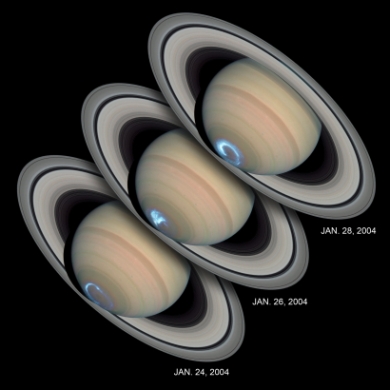Saturn's aurorae defy scientists' expectations [heic0504]
17 February 2005
The dancing light of the aurorae on Saturn behaves in ways different from how scientists have thought possible for the last 25 years. New research by a team of US and European planetary scientists led by John Clarke of Boston University, USA, has overturned theories about how Saturn's magnetic field behaves and how its aurorae are generated.By choreographing the instruments aboard the Earth-orbiting Hubble Space Telescope and the Cassini spacecraft, while it was en route to Saturn, to look at Saturn's southern polar region, Clarke and his team found that the planet's aurorae - long thought of as a cross between those of Earth and Jupiter - are fundamentally unlike those observed on either of the other two planets. The lights that occasionally fill the sky over Saturn may, in fact, be a phenomenon unique within our solar system.
In Clarke's experiment, Hubble snapped ultraviolet pictures of Saturn's aurorae over several weeks and Cassini recorded radio emissions from the same regions while measuring the solar wind, a stream of charged particles that trigger aurorae. Those sets of measurements were combined to yield the most accurate glimpse yet of Saturn's aurorae.
 |
|
Dynamic Aurorae on Saturn |
The observations also indicated, surprisingly, that the solar wind may play a much larger role in Saturn's aurorae than previously suspected. Hubble images, when combined with Cassini measurements of the solar wind, show that it is the pressure of the solar wind that appears to drive auroral storms on Saturn. In Earth's case, it is mainly the Sun's magnetic field, carried in the solar wind that drives auroral storms. In Saturn’s case the orientation of the magnetic field plays no major role.
Seen from space, an aurora appears as a ring of light circling a planet's polar region, where magnetic poles typically reside. Auroral displays are initiated when charged particles in space collide with a planet's magnetic field and stream into the upper atmosphere. Collisions with gases in the planet's atmosphere produce flashes of glowing energy in the form of light and radio waves.
Scientists had long believed Saturn's aurorae possess properties akin to both Earth and Jupiter. Like Earth's, they were thought to be influenced by the solar wind. Like Jupiter's, they were assumed to be influenced by a ring of ions and charged particles encircling the planet. The new results do show, however, a feature of Saturn's aurorae that matches Earth's: Radio waves appear to be tied to the brightest auroral spots. This similarity suggests that the physical processes that generate these radio waves is just like those of Earth.
But, as the team observed, though Saturn's aurorae do share characteristics with the other planets, they are fundamentally unlike those on either Earth or Jupiter. When Saturn's aurorae become brighter (and thus more powerful), the ring of energy encircling the pole shrinks in diameter. When Earth's aurorae become brighter, the polar region for several minutes is filled with light. Then the ring of light dims and begins to expand. Jupiter's aurorae, however, are only weakly influenced by the solar wind, becoming brighter about once a month, at the most, in response to solar wind changes. Recent model work has suggested that the key feature that make Saturn’s magnetic environment special, is Saturn’s strong magnetic field that works together with a dominating process where the magnetic field lines break and re-connect with other lines.
Saturn's auroral displays also become brighter on the sector of the planet where night turns to day as the storms increase in intensity, unlike either of the other two planets. The new images also confirm that, at certain times, Saturn's auroral ring was more like a spiral, its ends not connected as the energy storm circled the pole.
Now that Cassini has entered orbit around Saturn, Clarke and his team will be able to take a more direct look at the how the planet's aurorae are generated. The team is planning to probe how the Sun's magnetic field may fuel Saturn's aurorae and what role the solar wind may play.
# # #
Notes for editors
The Hubble Space Telescope is a project of international cooperation between ESA and NASA.
Image credit: NASA, ESA, J. Clarke (Boston University), and Z. Levay (STScI)
For more information, please contact:
Jean-Claude Gérard
Liege University, Belgium
Tel: +32-(0)4-366-97-75
E-mail: JC.Gerard ulg.ac.be
ulg.ac.be
John Terrel Clarke
Boston University
Tel: +1-617-353-0247
E-mail: jclarke bu.edu
bu.edu
Lars Lindberg Christensen
Hubble European Space Agency Information Centre, Garching, Germany
Tel: +49-(0)89-3200-6306
Cellular: +49-(0)173-3872-621
E-mail: lars eso.org
eso.org
Dolores Beasley
NASA Headquarters, Washington, USA
Tel: +1-202-358-1753
E-mail: dbeasley hq.nasa.gov
hq.nasa.gov
Donna Weaver
Space Telescope Science Institute, Baltimore, MD
Phone: +1-410-338-4493
E-mail: dweaver stsci.edu
stsci.edu
Ann Marie Menting
Boston University, Boston, MA
Phone: +1-617-353-2240
E-mail: amenting bu.edu
bu.edu
Carolina Martinez
NASA Jet Propulsion Laboratory, Pasadena, CA
Phone: +1-818-354-9382
E-mail: carolina.martinez jpl.nasa.gov
jpl.nasa.gov


